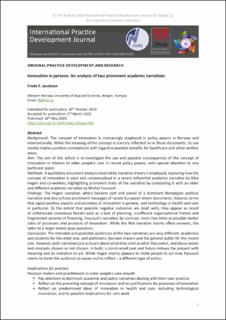| dc.description.abstract | Background: The concept of innovation is increasingly employed in policy papers in Norway and internationally. While the meaning of the concept is scarcely reflected on in those documents, its use mostly implies positive connotations with regard to possible benefits for healthcare and other welfare areas.
Aim: The aim of this article is to investigate the use and possible consequences of the concept of innovation in relation to older people’s care in recent policy papers, with special attention to one particular paper.
Methods: A qualitative document analysis inspired by narrative theory is employed, exploring how the concept of innovation is used and contextualised in a recent influential academic narrative by Kåre Hagen and co-workers, highlighting prominent traits of the narrative by contrasting it with an older and different academic narrative by Michel Foucault.
Findings: The Hagen narrative, which became part and parcel of a dominant Norwegian political narrative and also echoes prominent messages of recent European Union documents, features terms that signal positive aspects and promises of innovation in general, and technology in health and care in particular. To the extent that possible negative outcomes are dealt with, they appear as result of unfortunate contextual factors such as a lack of planning, insufficient organisational frames and fragmented systems of financing. Foucault’s narrative, by contrast, more than hints at possible darker sides of processes and products of innovation. While the first narrative mainly offers answers, the latter to a larger extent pose questions.
Conclusion: The intended and potential audiences of the two narratives are very different: academics and students for the older one, and politicians, decision makers and the general public for the recent one. However, both narratives are as much about what they omit as what they select, and about words and concepts chosen or not chosen. In both, a constructed past and future imbues the present with meaning and an invitation to act. While Hagen mainly appears to invite people to act now, Foucault seems to invite the audience to pause and to reflect – a different type of action.
Implications for practice:
Decision makers and practitioners in older people’s care should:
Pay attention to dominant academic and policy narratives dealing with their own practice
Reflect on the prevailing concept of innovation and on justifications for processes of innovation
Reflect on predominant ideas of innovation in health and care, including technological innovation, and its possible implications for care workInernational Practice
Reflect on how present narratives of innovation may influence their ideas of what is important in care work
Hasten slowly or pause when invited to engage in processes where the explicit aim is innovation
Realise that facilitation skills must include the ability to value team experiences, recognise learning needs, provide feedback and participate in finding solutions in the moment
View flexibility as important in terms of how new knowledge can be used in person-centred ways, notably in attempts to reduce the use of restraint in dementia care | en_US |

